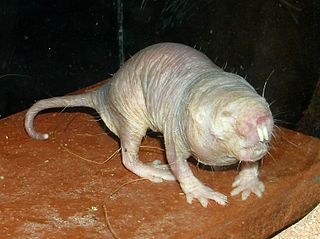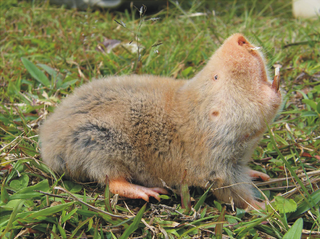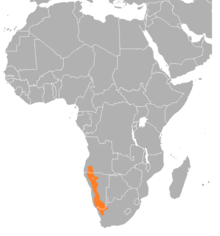
The maned rat or (African) crested rat is a nocturnal, long-haired and bushy-tailed East African rodent that superficially resembles a porcupine. The world's only poisonous rodent, the maned rat borrows toxins from plants to fend off predators.

Pouched rats are a group of African rodents in the subfamily Cricetomyinae. They are members of the family Nesomyidae, which contains other African muroids such as climbing mice, Malagasy mice, and the white-tailed rat. All nesomyids are in the superfamily Muroidea, a large and complex clade containing 1⁄4 of all mammal species. Sometimes the pouched rats are placed in the family Muridae along with all other members of the superfamily Muroidea.
The term rock rat has been used for several different types of rodents:

The Laotian rock rat or kha-nyou, sometimes called the "rat-squirrel", is a species of rodent found in the Khammouan region of Laos. The species was first described in a 2005 article by Paulina Jenkins and coauthors, who considered the animal to be so distinct from all living rodents, they placed it in a new family, Laonastidae. It is in the monotypic genus Laonastes.

Gundis or comb rats are a group of small, stocky rodents found in Africa. They live in rocky deserts across the northern parts of the continent. The family comprises four living genera and five species, as well as numerous extinct genera and species. They are in the superfamily Ctenodactyloidea. Local people in northern Africa have always known about gundis, however they first came to the notice of western naturalists in Tripoli in 1774, and were given the name gundi mice. While they are not regarded as pests, some people hunt gundis for food.

The blesmols, also known as mole-rats, or African mole-rats, are burrowing rodents of the family Bathyergidae. They represent a distinct evolution of a subterranean life among rodents much like the pocket gophers of North America, the tuco-tucos in South America, or the Spalacidae from Eurasia.

Petromuridae is a family of hystricognath rodents that contains the dassie rat (Petromus typicus) of southwestern Africa, the only extant member of this group.

The rodent parvorder or infraorder Phiomorpha comprises several living and extinct families found wholly or largely in Africa. Along with Anomaluromorpha and perhaps the extinct Zegdoumyidae, it represents one of the few early colonizations of Africa by rodents.

The Gambian pouched rat, also commonly known as the African giant pouched rat, is a species of nocturnal pouched rat of the giant pouched rat genus Cricetomys, in the family Nesomyidae. It is among the largest muroids in the world, growing to about 0.9 m (3 ft) long, including the tail, which makes up half of its total length. It is widespread in Sub-Saharan Africa, ranging from Senegal to Kenya and from Angola to Mozambique from sea level to 2,000 m (6,600 ft).

The silvery mole-rat, silvery blesmol, or silky mole-rat is a species of mole-rat of East Africa which occurs in southern Kenya, Tanzania, southeastern Democratic Republic of Congo, Mozambique and Malawi. Solitary and aggressive, little is known about its ecology or behavior. It is monotypic in the genus Heliophobius. A common species, the International Union for Conservation of Nature has rated it as being of "least concern".

The black-tailed tree rat, also called black-tailed acacia rat or black-tailed thallomys,, is a species of rodent in the family Muridae. It is found in Angola, Botswana, Namibia and South Africa, where its natural habitat is subtropical or tropical dry shrubland. It is both nocturnal and arboreal and makes bulky nests in the trees, often acacias, where it feeds on leaves and buds.
The rock dormouse or flat-headed African dormouse is a species of rodent in the family Gliridae. It is found in Botswana, Mozambique, South Africa, Eswatini, Zambia, and Zimbabwe where it lives among rocks in upland areas. It is a fairly common, mainly nocturnal species and the International Union for Conservation of Nature has assessed its conservation status as being of "least concern".
The stone dormouse is a species of rodent in the family Gliridae. It is found in Namibia, South Africa, and possibly Angola. Its natural habitat is rocky areas in the Karoo. Though it has a limited range, it is a fairly common species and the International Union for Conservation of Nature has assessed its conservation status as being of "least concern".
The mountain viscacha rat or mountain vizcacha rat, historically viscacha rat or vizcacha rat, is a species of rodent in the family Octodontidae. It is endemic to Argentina.

The big-headed African mole rat, also known as the giant root-rat, Ethiopian African mole rat, or giant mole rat, is a rodent species in the family Spalacidae. It is endemic to Ethiopia's Bale Mountains. Its natural habitat is subtropical or tropical high-altitude grassland, where it can reach densities of up to 2,600 individuals per square kilometre. It is threatened by habitat loss. Where the two species overlap, it is the main prey of the endangered Ethiopian wolf.

The yellow-spotted rock hyrax or bush hyrax is a species of mammal in the family Procaviidae. It is found in Angola, Botswana, Burundi, the Democratic Republic of the Congo, southern Egypt, Eritrea, Ethiopia, Kenya, Malawi, Mozambique, Rwanda, Somalia, northern South Africa, South Sudan, Sudan, Tanzania, Uganda, Zambia, and Zimbabwe. Its natural habitats are dry savanna and rocky areas. Hyrax comes from the Greek word ὕραξ, or shrew-mouse.

The Bunyoro rabbit or Central African rabbit is a species of mammal in the family Leporidae. It is monotypic within the genus Poelagus. It is found in central Africa and its typical habitat is damp savannah, often with rocky outcrops.
The Uspallata chinchilla rat is a species of chinchilla rat in the family Abrocomidae native to Argentina. This species was identified in 2002, by Braun and Mares from the University of Oklahoma. Only a single specimen has been examined.

The highlands punaré is a caviomorph rodent of South America from the spiny rat family. It is endemic to gallery forest, savanna and rocky outcrop habitats in Bahia State within the Caatinga ecoregion of eastern Brazil at elevations from 260 m to 1030 m. It sometimes nests and often takes refuge in crevices in rock formations, as means of both predator avoidance and moderating temperature extremes. The species tolerates a degree of habitat disturbance. Although hunted, it is considered common throughout its range. Its karyotype has 2n = 26 and FN = 48.
















